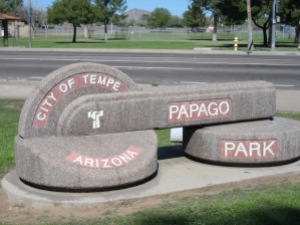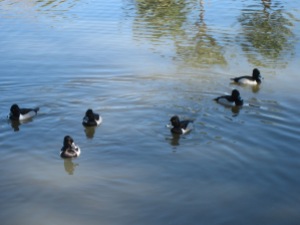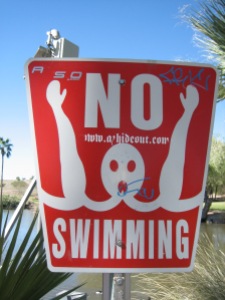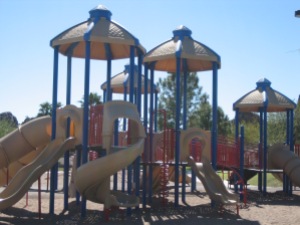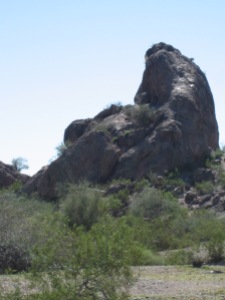The Desert Botanical Garden is located at 1201 N Galvin Pkwy, Phoenix, AZ. According to https://en.wikipedia.org/wiki/Desert_Botanical_Garden, it
is a 140 acres…botanical garden located in Papago Park…
Founded by the Arizona Cactus and Native Flora Society in 1937[1] and established at this site in 1939, the garden now has more than 21,000 plants, in more than 4000 taxa, one-third of which are native to the area, including 139 species which are rare, threatened or endangered.
…It focuses on plants adapted to desert conditions, including an Australian collection, a Baja California collection and a South American collection. Several ecosystems are represented: a mesquite bosque, semidesert grassland, and upland chaparral.

This 20 foot tall saguaro sculpture on display at the Desert Botanical Garden was created by Jeff Hebets in honor of his cousin, Phil. The saguaro is made from pick heads used to salvage native plants.
Admission to the Desert Botanical Garden is a bit pricey: $22 for adults 18-59, with only a $2 discount to seniors. I am fortunate to have a friend with a membership to the Garden. Not only does she get in for free, but one guest can get in for free with her. My friend treated me to a morning in the Garden.
There are five trails in the Garden: the Desert Discovery Loop Trail, the Plants & People of the Sonoran Desert Loop Trail, the Sonoran Desert Nature Loop Trail, the Center for Desert Living Trail, and the Harriet K. Maxwell Desert Wildflower Loop Trail.
My friend and I were only at the Botanical Garden for a couple of hours, so by no means did we see it all. My favorite part of the visit was seeing cacti that were new to me, ones that I hadn’t already seen hundreds of times in far south Arizona.

The cactus on the far left of this photo is an old man of the Andes (scientific name: Oreocereus celsianus).
One new variety I saw was the Old Man of the Andes (scientific name: Oreocereus celsianus). According to https://en.wikipedia.org/wiki/Oreocereus_celsianus,
Oreocereus celsianus, or the “old man of the mountain” is a member of the family Cactaceae native to the high lands of the Andes in South America, and is named for its fluffy white hair, which may protect it from intense sunlight and extreme temperatures.
The Learn 2 Grow website says,
Old Man of the Andes is a striking cylindrical cactus due to its coat of dirty blond coarse hairs that covers its entire length. These hairs help protect and shade its green skin from both intense high altitude sunlight and the occasional cold snap. The species is native to Bolivia, Peru and northern Argentina where it is found on rocky cliffs at high elevations of the Andes and other mountain ranges.
While the Old Man of the Andes looks rather fluffy and huggable (at least to me), Learn 2 Grow warns,
This cactus is well armed. Spines are stout, thick, and dirty yellow to reddish brown in color. They occur in groups from one to four heavier spines surrounded by 7 to 9 very sharp radial spines. These sit nestled deeply into the hairy cloak.
No hugs for you, Old Man!
Another new variety I saw was the Bishop’s Hat (scientific name: Astrophytum myriostigma). This cactus looks as if it were made from cloth!
According to https://en.wikipedia.org/wiki/Astrophytum_myriostigma,
Astrophytum myriostigma (common names: Bishop’s Cap Cactus, Bishop’s Hat or Bishop’s Miter Cactus) is a species of cactus native to the highlands of northeastern and central Mexico.
The Plants Rescue website says,
The basically green stem has no spine but is covered with tiny tufts of silvery hair (appearing like scales or spots). These give the plant a greyish cast.
It wasn’t quite spring when I went on this visit, so there weren’t many cacti in bloom. The few early bloomers I did see were quite lovely.
I had a nice time at the Desert Botanical Garden. Since my friend and I went early in the day, we didn’t have to fight any crowds. Thankfully, there were no groups of screaming school kids. Being near these various plants seemed very tranquil to me. However, as I write this post, I realize I didn’t take nearly enough photos. (What about the boojum trees? Why didn’t I get any pictures of the boojum trees?) Maybe my friend will treat me to another visit.
I took all of the photographs in this post.




